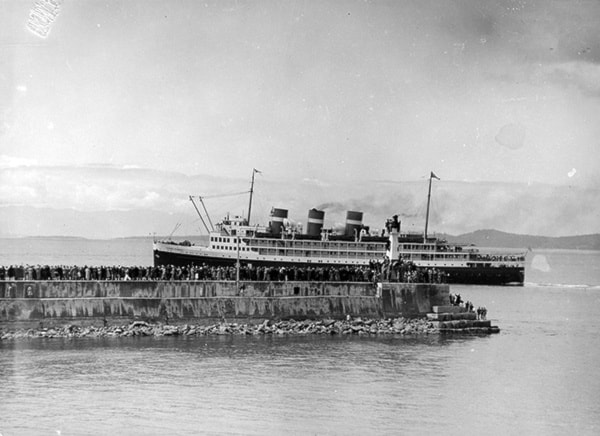Confidently jutting 762 metres into open ocean, the Dallas Road breakwater has defined the meeting point of land and sea adjacent to Victoria’s international seaport at Ogden Point for generations.
Its origins a century ago highlight Victoria’s emergence as a bustling maritime city linked to important imperial trade and tourism routes. Hoping to harness an economic boom after the opening of the Panama Canal, then under construction in 1912, the breakwater project reflected the capital city’s grand ambitions to position itself as the most important British seaport in the Pacific.
By 1912, 2,500 ships of all sizes representing over three million tons of shipping berthed annually in Victoria. In the era before jet engines, steamship lines connected Victoria with ports in Liverpool, Glasgow, New York, Antwerp, New Zealand, Australia, South America and “the Orient.” Early sea voyages to Victoria were often dangerous and maritime tragedies such as the grounding of the SS Valencia in 1906 and the sinking of the ships Sechelt and Iroquois in 1911 weighed heavily on people’s minds.
Harry Barnard, a prominent lawyer and politician who later served as a member of Parliament and senator, was concerned that Victoria might lose its leading maritime position without a plan to modernize its port facilities. He used his leverage on the Board of Trade to persuade Prime Minister Robert Borden to commission a study for the redevelopment of Victoria’s port infrastructure around the docks at Rithet’s Pier (the current site of the Canadian Coast Guard base in James Bay). Louis Coste, the chief engineer, recommended an ambitious development including new deep water docks and a breakwater at Ogden Point (a second breakwater at Macaulay Point was proposed but never built) to mitigate the rough waves and winds from the Juan de Fuca Strait.
The plan generated tremendous excitement in the local press. A full-page editorial in July 1912 extolled the virtues of the “growing position of Victoria as a great port” and expressed enthusiasm that the Dominion Government had announced their intentions to construct a “big breakwater” at Ogden Point.
On Oct. 18, 1912, the government awarded the breakwater contract to the British firm of Sir John Jackson, heralded by the press as the “greatest firm of constructional engineers in the world.” The local firm of A.J. Ratfliff & Co. was assigned to build two massive derricks, powered by steam engines, to lift the heavy stone material. Construction began in 1913 and the government provided $5 million for the breakwater and adjacent docks at Ogden Point.
The Royal Bay quarry in Colwood was secured to supply over one million tonnes of rock and rubble for the breakwater’s underwater foundation. Ten thousand granite blocks quarried on Hardy Island were shipped by barge to Ogden Point to construct the breakwater’s surface in a layered pyramid design. A concrete shell provided the superstructure. At the time, it was British Columbia’s largest ever construction project.
On Jan. 22, 1917, the last granite block was ceremonially laid at the parapet. Flags were raised at both ends of the breakwater, champagne flowed, toasts and congratulatory speeches were made, and a deafening chorus of whistles and horns from nearby industrial plants and passing steamships announced the triumphant conclusion of four years of hard work. As a testament to its design brilliance, only minor repairs have been required after nearly a century of exposure to the elements.
The following year, Parfitt Brothers constructed the small lighthouse at the end of the breakwater to house a powerful lighting beacon.
For decades, the breakwater provided protection to the Ogden Point port and helped to spur an economic boom in shipping and industrial activity. For passengers on the great Canadian Pacific Empress ships, the appearance of the stately breakwater through the mist after a long sea voyage announced their impending arrival at port.
In the modern era, the breakwater has become a stage for walkers, bird watchers, fishers and scuba divers – attracted by incomparable views of the majestic Olympic Mountains and the unique diversity of nearby marine life.
In 2002, the Greater Victoria Harbour Authority assumed ownership of the breakwater and Ogden Point properties from Transport Canada. Beginning in 2009, the Unity Wall mural project transformed the breakwater into a canvas for First Nations artists to share traditional stories and to create a bridge between cultures. In 2013, the Harbour Authority invested $500,000 to install safety handrails. Since then, walking numbers have exploded with people of all ages and abilities taking part. In February 2015, staff at Ogden Point counted pedestrian traffic and were astonished to learn that during one of the bitterest months of the year, nearly 32,000 people walked the breakwater. One can only imagine the number of walkers during the warm summer months.
In January 2017, the breakwater will celebrate its 100th birthday during the same year that Canada turns 150. It will be a wonderful opportunity to honour the breakwater’s origins as a British engineering triumph as well as its current role as a nationally significant local treasure that not only connects visitors with land and sea, but with the past, present and future of our great maritime city.
lll
Ivan Watson is an historian and media relations specialist for the Greater Victoria Harbour Authority. You can follow him on Twitter @watsonivan or email him feedback at: iwatson@gvha.ca.
